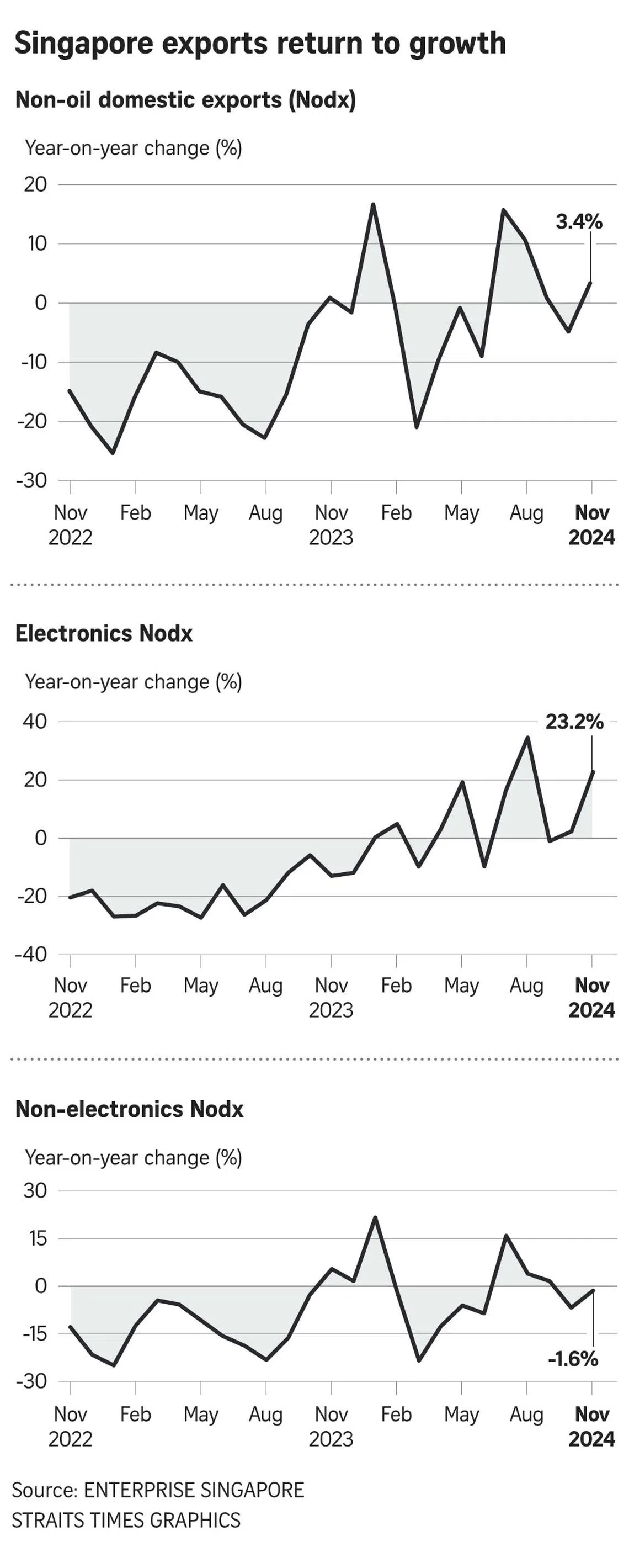Singapore key exports see surprise rebound in November on electronics growth
Sign up now: Get ST's newsletters delivered to your inbox

Analysts said exporters might be front-loading their shipments before US President-elect Donald Trump’s proposed tariffs kick in.
PHOTO: ST FILE
Follow topic:
SINGAPORE - Singapore’s key exports enjoyed a rebound in November, beating analyst expectations, as electronics shipments resumed a double-digit expansion.
This might be due to exporters front-loading their shipments before US President-elect Donald Trump’s proposed tariffs kick in, experts said.
Non-oil domestic exports (Nodx) grew 3.4 per cent from a year ago, reversing a revised 4.7 per cent drop in October, according to figures released by trade agency Enterprise Singapore (EnterpriseSG) on Dec 17.
Analysts polled by Bloomberg had expected a 1 per cent fall in Nodx.
This also comes after Singapore in November again cut its 2024 full-year forecast for key export growth to around 1 per cent – down from August’s estimate of 4 per cent to 5 per cent – due to a worse-than-expected recovery in the second half of 2024.
For 2025, Nodx is expected to grow by 1 per cent to 3 per cent.
DBS Bank economist Chua Han Teng said: “Singapore’s positive Nodx performance could continue through the end of 2024 and into early 2025, potentially supported by near-term front-loading of shipments, as firms anticipate potentially higher tariffs under a second Trump presidency.”
Maybank Investment Banking Group economist Brian Lee agreed that exports and manufacturing should remain resilient in the first half of 2025, boosted by the front-loading of orders.
“Another bright spot to the sector stems from the wider China-Asean tariff gap (owing to the additional 10 per cent tariff rate on Chinese imports to be imposed by the US), which could accelerate the shift in manufacturing activity to Asean, including Singapore.”
November’s rebound came as a result of electronics exports rising 23.2 per cent that month on a year-on-year basis, much faster than the 2.6 per cent growth in October.
Within this segment, exports of integrated circuits, also known as chips or semiconductors, expanded by 28.9 per cent, while disk media products grew by 114.7 per cent. Personal computers also grew by 75.3 per cent.
Mr Chua said that Singapore’s electronics exports upcycle remains well intact, and he anticipates continued resilient expansion to support overall Nodx momentum into early 2025.
“This will be underpinned by sturdy external demand for Singapore’s electronics products, which can be observed from the ongoing multi-month expansion in electronics new export orders that is benefiting from the rising adoption of artificial intelligence applications in consumer devices amid an ongoing replacement cycle,” he said.
But UOB associate economist Jester Koh said that while the electronics performance remained resilient, the cycle could peak in the months ahead.
November’s data also showed that non-electronics exports continued to contract, by 1.6 per cent, although this was an improvement from the 6.8 per cent drop in the previous month.
The decline was driven by the volatile pharmaceutical segment, which fell by 63.8 per cent. Meanwhile, petrochemicals fell by 5.3 per cent, and paper and paperboard dropped by 89.9 per cent.
On a month-on-month seasonally adjusted basis, Nodx expanded by 14.7 per cent in November, after the 7.5 per cent decline in the previous month. Both electronics and non-electronics grew.
Exports to Taiwan, Hong Kong and Malaysia grew in November.
Exports to Taiwan grew by 42.7 per cent, on the back of an expansion in specialised machinery, measuring instruments and integrated circuits.
Exports to Hong Kong expanded by 35.3 per cent, reversing the 19.8 per cent contraction in the preceding month, thanks to integrated circuits, non-monetary gold and personal beauty products.
Meanwhile, exports to Malaysia rose by 24.4 per cent, owing to integrated circuits, other computer peripherals and disk media products.
However, exports to the US, China, Japan, Thailand and the euro zone declined.

Analysts cautioned that 2025’s export outlook remains uncertain with Trump set to take office again in January.
DBS’ Mr Chua said: “The intensification of geopolitical and trade tensions will pose medium-term challenges and downside risks to the growth of highly trade-dependent economies like Singapore.”
Maybank’s Mr Lee said a key downside risk is that Trump could target tariffs at specific Asean countries or introduce blanket tariffs on the rest of the world.
“This could disrupt trade flows and short-circuit the reconfiguration of supply chains to South-east Asia, including Singapore.
“Other countries may retaliate against the US, which could escalate the trade war and further impact global trade and external demand,” he added.


